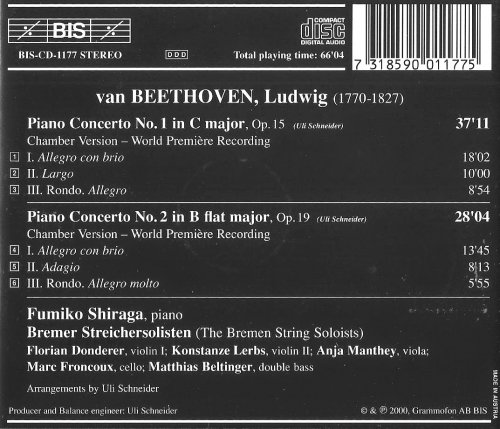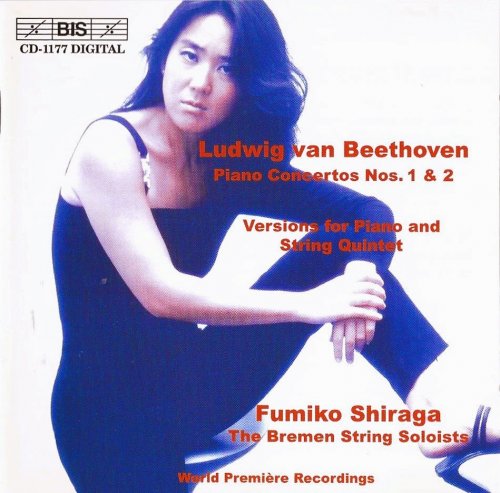
Fumiko Shiraga - Beethoven: Piano Concertos Nos. 1 & 2 (2001)
BAND/ARTIST: Fumiko Shiraga
- Title: Beethoven: Piano Concertos Nos. 1 & 2
- Year Of Release: 2001
- Label: BIS
- Genre: Classical
- Quality: FLAC (image+.cue,log,scans)
- Total Time: 01:06:04
- Total Size: 304 Mb
- WebSite: Album Preview
Tracklist:
01. Piano Concerto No.1 in C major, Op. 15 - I. Allegro con brio [0:18:16.65]
02. Piano Concerto No.1 in C major, Op. 15 - II. Largo [0:10:03.57]
03. Piano Concerto No.1 in C major, Op. 15 - III. Rondo. Allegro [0:09:17.18]
04. Piano Concerto No.2 in B flat major, Op. 19 - I. Allegro con brio [0:13:54.00]
05. Piano Concerto No.2 in B flat major, Op. 19 - II. Adagio [0:08:14.65]
06. Piano Concerto No.2 in B flat major, Op. 19 - III. Rondo. Allegro molto [0:06:20.27]
Performers:
Fumiko Shiraga - piano
Bremer Streichsolisten

01. Piano Concerto No.1 in C major, Op. 15 - I. Allegro con brio [0:18:16.65]
02. Piano Concerto No.1 in C major, Op. 15 - II. Largo [0:10:03.57]
03. Piano Concerto No.1 in C major, Op. 15 - III. Rondo. Allegro [0:09:17.18]
04. Piano Concerto No.2 in B flat major, Op. 19 - I. Allegro con brio [0:13:54.00]
05. Piano Concerto No.2 in B flat major, Op. 19 - II. Adagio [0:08:14.65]
06. Piano Concerto No.2 in B flat major, Op. 19 - III. Rondo. Allegro molto [0:06:20.27]
Performers:
Fumiko Shiraga - piano
Bremer Streichsolisten
This is another of Fumiko Shiraga's experimental renderings of well known piano concertos in chamber music format. I was hugely impressed by her performances of the two Chopin concertos with string quintet when I recently reviewed them. They were justified, I thought, because (a) there was some evidence that Chopin may have performed them in that format, and (b) the composer inhabited a creative world that was chamber in intimacy and scale.
Justification in the case of the Beethoven concertos is weaker. Ralf Schnitzer, at the start of his article in the booklet, asks, "Beethoven's two early piano concertos with string quintet instead of orchestra - why make such a recording?"
In the four pages that follow, no answer is volunteered. What can be said, by way of stating the obvious, is that Beethoven wrote the works before his First Symphony at a time when he was experienced in writing chamber works but was still cutting his teeth as an orchestral composer. Nevertheless, these renderings rarely sound like chamber works and especially not Beethoven ones. The composer is already beginning to try out the piano/orchestra adversarial approach (especially in the First Concerto which he wrote second). The orchestra has a personality of its own with the ability to present a range of tonal colour that Beethoven well exploits. These characteristics do not apply in the case of the Chopin concertos to anything like the same extent hence their easier transposition to chamber mode.
So with little or nothing to justify the arrangements from a historical/authenticity standpoint, the focus is directed firmly towards the quality of performance.
Shiraga's direct, fresh and unmannered style is particularly suited to these relatively youthful works. It also matches the percussive immediacy of the chamber sound. She has clearly formed a perfect understanding with her Bremen String Soloists just as she had with the Yggdrasil Quartet in the Chopin. Her relatively sparing use of pedal lends a spring and clarity to her playing. Some people may feel her steadiness occasionally over controlled - for example, many pianists make the minor episode in the finale of the First Concerto, known by some in the trade as the "rumba" section, dance more dramatically, although in the first movement cadenza she really fizzes in a way that I found exceptionally exciting.
This returns me to issues concerning the arrangements. That cadenza, with Shiraga powering away on her modern Yamaha in concert hall mode (taking up a quarter of the movement), seems to me to unbalance a movement otherwise presented as chamber music. There is an incongruity about it. Another issue is the occasional support the piano gives to the Bremen soloists in the original score’s orchestral passages. For example, Shiraga beefs up the First Concerto’s opening tutti by thumping in immediately at the repeat of the first subject a few bars from the beginning. The result is that the effect of Beethoven’s intended magical entry of the piano much later, with its surprising new melody, is gone. So an important statement in the musical narrative loses its force.
Nevertheless, these performances are such that I am glad to own the disc and will return to them for their clarity, poise, excitement and the restrained beauty of the slow movements.
The recorded sound is very fine and captures the closeness of a chamber ambience. -- John Leeman
Justification in the case of the Beethoven concertos is weaker. Ralf Schnitzer, at the start of his article in the booklet, asks, "Beethoven's two early piano concertos with string quintet instead of orchestra - why make such a recording?"
In the four pages that follow, no answer is volunteered. What can be said, by way of stating the obvious, is that Beethoven wrote the works before his First Symphony at a time when he was experienced in writing chamber works but was still cutting his teeth as an orchestral composer. Nevertheless, these renderings rarely sound like chamber works and especially not Beethoven ones. The composer is already beginning to try out the piano/orchestra adversarial approach (especially in the First Concerto which he wrote second). The orchestra has a personality of its own with the ability to present a range of tonal colour that Beethoven well exploits. These characteristics do not apply in the case of the Chopin concertos to anything like the same extent hence their easier transposition to chamber mode.
So with little or nothing to justify the arrangements from a historical/authenticity standpoint, the focus is directed firmly towards the quality of performance.
Shiraga's direct, fresh and unmannered style is particularly suited to these relatively youthful works. It also matches the percussive immediacy of the chamber sound. She has clearly formed a perfect understanding with her Bremen String Soloists just as she had with the Yggdrasil Quartet in the Chopin. Her relatively sparing use of pedal lends a spring and clarity to her playing. Some people may feel her steadiness occasionally over controlled - for example, many pianists make the minor episode in the finale of the First Concerto, known by some in the trade as the "rumba" section, dance more dramatically, although in the first movement cadenza she really fizzes in a way that I found exceptionally exciting.
This returns me to issues concerning the arrangements. That cadenza, with Shiraga powering away on her modern Yamaha in concert hall mode (taking up a quarter of the movement), seems to me to unbalance a movement otherwise presented as chamber music. There is an incongruity about it. Another issue is the occasional support the piano gives to the Bremen soloists in the original score’s orchestral passages. For example, Shiraga beefs up the First Concerto’s opening tutti by thumping in immediately at the repeat of the first subject a few bars from the beginning. The result is that the effect of Beethoven’s intended magical entry of the piano much later, with its surprising new melody, is gone. So an important statement in the musical narrative loses its force.
Nevertheless, these performances are such that I am glad to own the disc and will return to them for their clarity, poise, excitement and the restrained beauty of the slow movements.
The recorded sound is very fine and captures the closeness of a chamber ambience. -- John Leeman

Classical | FLAC / APE | CD-Rip
As a ISRA.CLOUD's PREMIUM member you will have the following benefits:
- Unlimited high speed downloads
- Download directly without waiting time
- Unlimited parallel downloads
- Support for download accelerators
- No advertising
- Resume broken downloads


